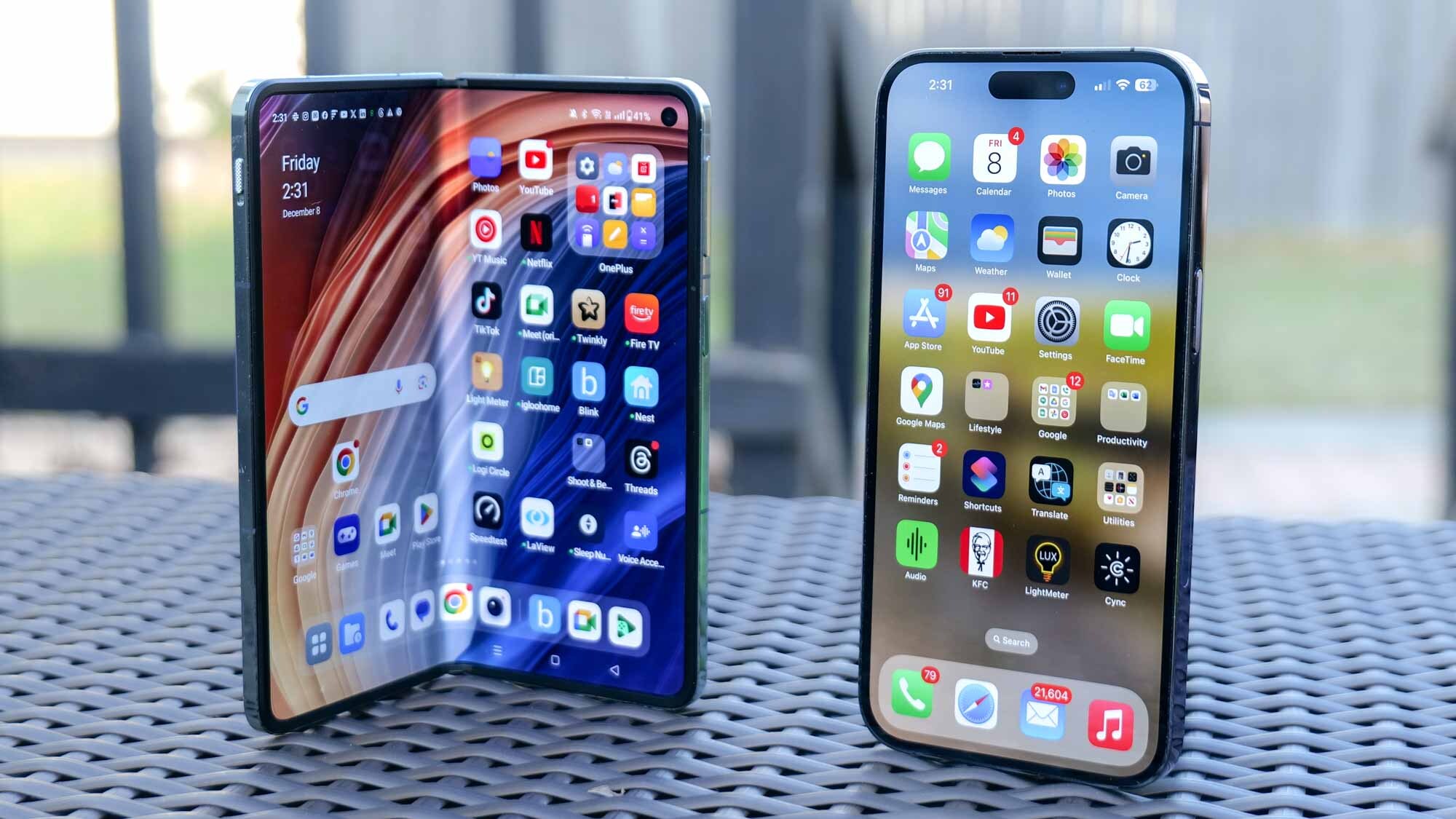I ditched the iPhone 15 Pro for the OnePlus Open — 5 things I discovered after using a foldable
Open sesame!

The OnePlus Open is — to me at least — the most exciting phone of 2023. True, the Pixel Fold is the more noteworthy, the iPhone 15 is the best for most people and the Zenfone 10 is my personal favorite. But the OnePlus Open is the most exciting.
Why? Quite simply because it leans in to what foldables do well while making substantial gains everywhere else. And on a first attempt, too.
My colleague John Velasco put the Open through its paces in his comprehensive OnePlus Open review, but I’ve also had a chance to use the device for a spell. This’ll be a much less thorough examination, but ditching my current daily driver (the iPhone 15 Pro) for the Open has given me some serious pause for thought. The experience has been enough to convince me foldable phones are a Very Good Thing, but I still think there’s some way to go before they displace candybar phones for most of us.

There are the obvious things; like the cost and the fact it’ll take developers a while to optimize code for the foldable form factor. But more so than that, my concern is the durability and reliability of these things over several years. We’re holding on to our phones for longer and longer and, personally, I need to be sure my device is going to withstand the rigors of several years’ use. And I work in an office environment.
What about those folks working construction? Or landscaping? Or in the military? Are they going to opt for a foldable that’ll keep up with the demands of their daily use cases? The Open is IPX4 rated — so it’ll survive splashes and possibly some heavy rain, but I don’t imagine it’ll be the go-to device if you spend a lot of time in or around open water.
That being said, I don’t want to dunk on foldables. They’re the coolest thing to happen to the phone industry in a few years and they can only get better as the category matures. As production becomes more efficient and competition increases, prices will reduce. And the more folding phones that manufacturers bring to market, the better they’ll get at improving things like durability and, ahem, how noticeable the crease is.

It’s been a year or two since I last spent any real time with a foldable phone, so I was all too happy to spend some quality hands-on weeks with the Open. I loved the fact that, despite being a book-style foldable, it’s skinnier than the Samsung Galaxy Fold 5 or the Pixel Fold at just 0.22-inches thin. And it weighs just 8.43 ounces. You can almost fool yourself into thinking you’re using a traditional candybar phone. Better yet, the hinge design feels tough and resilient.
If the design was the main reason for my excitement about the Open, the camera was the second. Traditionally a lackluster area in the foldable game, OnePlus has furnished its device with a 48MP main camera, 48MP ultrawide, and a 64MP telephoto camera with 3x optical zoom. All of which are tuned by Hasselblad. That makes for a massive camera bump but also enough photographical power to pass muster — especially where low light was concerned. These are some shots that John took with his Open and they’re not bad at all.








So with both the design and the camera performance impressing me about the OnePlus Open, what happened when I traded in my trusty iPhone 15 Pro to use it as my daily driver? Here are my key takeaways after swapping to a foldable.
1. Android’s MagSafe rival needs to hurry up and arrive
Until I surrendered my iPhone 15 Pro, I hadn’t realized how much I relied on MagSafe and wireless charging in general. Whether I’m at home, at the office or even turning in for the night, there’s usually a MagSafe wireless charging stand nearby. Similarly, if I ever do need to charge up or carry a card or two with me, I turn to MagSafe battery packs or wallet cases.
This is a seamless experience on the iPhone but I had to go back to actually plugging in a charging cable when I switched to the Open. The Z Fold 5 and the Pixel Fold both have wireless charging but for some reason, OnePlus has neglected it on the Open. It’s a real shame and a big no bueno in my book for a phone closing in on a $2k cover price.
But it also speaks to a wider Android problem. The MagSafe sandbox is just so damn useful and convenient. This’ll come in time to Android phones but it needs to hurry up. While you can already buy adapters and cases to use MagSafe on Android phones, I really hope the advent of Qi2 is the tipping point. Well-crafted, premium magnetic wireless charging accessories should be here whether or not I’m using a OnePlus Open or a Motorola Edge+. Not having this was one of my biggest bugbears when switching away from the iPhone.
2. I did a lot more work on the move

Here’s the thing: foldable phones are just tailor-made for productivity. As my colleague Richard Priday found when he ditched his laptop for the OnePlus Open, you can handle a huge amount of work admin far, far better on the Open’s 7.82-inch Flexi-fluid AMOLED inner screen than you can on the 6.1-inch display on the iPhone 15 Pro. The 4:3 ratio makes spreadsheets, websites and browser-based applications like the Tom’s Guide CMS much easier to navigate.
While I previously would be pinching and zooming around a 16:9 landscape screen to find what I wanted, I could see it all laid out in front of me when I unfolded the Open. And if I wanted to watch some content? That’s what the 6.31-inch outer display is for. Moreover, thanks to the Open Canvas multitasking features, you can open two apps in split view and have a third floating off to the side that can then be tabbed over to if needed. It’s true that there are a few laggy bugs that crop up during use, but overall it’s a very good implementation that helps make this a good tool for office work.
3. It could mean the end of my Kindle
If productivity was the first revelation, the second was that I no longer needed to carry one of the best Kindles around with me to read during my commute or on a lunch break. Thanks to the Kindle app (or a decent PDF reader and the 512GB of internal storage space) the OnePlus Open had me covered for reading on the move.
4. Stability vs features?

I alluded to the occasional crashes in point two and this is where the Android/iOS dilemma can hot up a little bit. I know iOS isn’t perfect, but I’ve generally found it to be a more stable system for the core services I need from my phone. The apps are formatted correctly, the updates arrive in a timely manner and the crashes are fewer and further between. So, while I find Android more interesting for poking around inside, sideloading and general customization, I did miss that feeling of stability when I swapped to the Open.
OnePlus’ foldable runs OxygenOS 13.2 and the Chinese company has confirmed it’ll support the device with four years of OS upgrades and five years of security updates. While Apple doesn’t guarantee a specific length of time for upgrades, I’d be expecting at least five software updates and six years of security updates. You can still get iOS 17 on an iPhone XR.
For those people a little risk-averse, this could be an unspoken obstacle they need to overcome if they want to jump over from the safety net of an iPhone to a big-swinging Android foldable.’
5. Phones can still be fun
There’s a tendency for folks to get a little jaded where technology is concerned. And while AI may be hot stuff right now, spending time with Open convinced me that smartphone hardware can still be fun. It can still innovate and entice. After all — if it didn’t, you wouldn’t be reading this.
First gen products are always going to be a little rough-around-the-edges. The fact the Open is so polished for a first attempt is to be applauded. But I’m pretty sure foldables aren’t going anywhere and will just get better and better. It’s no small thing that Samsung's Drew Blackard told Tom’s Guide that, "our goal by 2025 is to have (foldables) be 50% of our global flagship mix." Based on my short time with this particular foldable, I’m fully behind that goal.
More from Tom's Guide
Sign up to get the BEST of Tom's Guide direct to your inbox.
Get instant access to breaking news, the hottest reviews, great deals and helpful tips.

Jeff is UK Editor-in-Chief for Tom’s Guide looking after the day-to-day output of the site’s British contingent.
A tech journalist for over a decade, he’s travelled the world testing any gadget he can get his hands on. Jeff has a keen interest in fitness and wearables as well as the latest tablets and laptops.
A lapsed gamer, he fondly remembers the days when technical problems were solved by taking out the cartridge and blowing out the dust.
